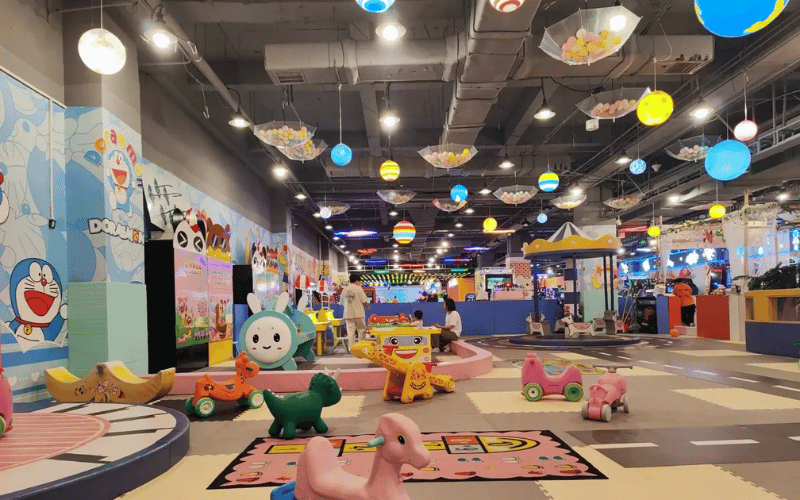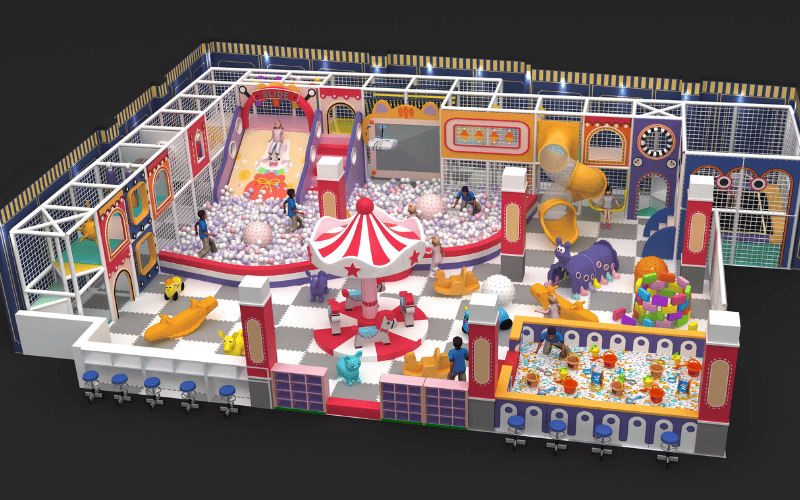Indoor playgrounds are a vibrant and rewarding business opportunity for families seeking a safe, interactive, and fun environment for their children. With the market forecast to grow at an impressive 9.79% CAGR and hit $42.64 billion by 2028, this sector offers substantial long-term potential for entrepreneurs willing to plan and execute thoughtfully.
This detailed guide reveals the key steps, strategies, and considerations for creating a thriving indoor playground business. Following these insights and actionable advice, you’ll have the tools to turn your vision into a profitable reality that brings joy to families and kids.
Table of Contents
ToggleIntroduction to the Indoor Playground Industry
Indoor playgrounds are more than entertainment venues; they cultivate learning, social interaction, and physical activity for children. Designed with features like soft climbing walls, themed play areas, interactive panels, and ninja courses, these spaces appeal to kids and parents alike.
The rising popularity of family-friendly recreation spaces, urbanization, and an emphasis on year-round play areas unaffected by weather conditions fuels the industry’s rapid growth. Beyond the feel-good aspects of the business, the profitability of indoor playgrounds is primarily driven by diverse revenue streams like birthday parties, memberships, and merchandise sales.
For entrepreneurs, this sector offers a unique blend of purpose and profit, where creating community bonds can directly lead to business success.

What Is Required to Begin Creating Your Indoor Playground Business Plan
Every successful indoor playground starts with a solid foundation. Here’s your checklist to kick things off:
Step 1. Research and Find the Ideal Location
The location of your playground is critical for attracting families. Areas with high foot traffic, such as malls, shopping centers, or family neighborhoods, are ideal. Proximity to schools or daycare centers boosts accessibility. When selecting a site, analyze:
- Visibility: Ensure your location is easy to find.
- Safety: Choose sites with ample parking and secure surroundings.
- Space Fit: Ensure the layout accommodates age-specific play zones.
Step 2. Identify and Understand Your Target Customers
Clarifying your target demographics helps customize your offerings. Are you catering to toddlers (ages 0-3), older kids (ages 4-12), or both? Delve into customer behaviors, such as preferences for themed zones or specific attractions. For instance:
- Toddlers’ Needs: Focus on soft play areas for free exploration.
- Older Kids’ Interests: Include obstacle courses, zip lines, and sensory-stimulating features.
Step 3. Create and Refine Your Budget
Depending on size, equipment, and design complexities, costs can range from $50,000 to $500,000. Break your budget into measurable components:
- Equipment and installation costs.
- Rent or purchase fees.
- Permits, insurance, and utility expenses.
- Marketing campaigns.
Tools like Excel or budgeting software help track and manage costs efficiently.
Step 4. Design an Effective Indoor Playground Layout
Work with professional designers to create a layout that includes:
- Dedicated Zones: Consider age-appropriate sections (e.g., toddler sensory walls vs. ninja structures for older kids).
- Seating Areas: Create comfortable rest zones for parents to enhance their experience.
- Safety Considerations: Ensure the layout promotes clear visibility for staff safety monitoring.
Step 5. Source High-Quality Equipment
From soft play setups to themed climbing frames, investing in safe, durable equipment is crucial. Consider:
- Customizability: Opt for modular designs to align with seasonal upgrades or market trends.
- Compliance: Ensure all equipment adheres to ASTM or CPSC standards.
- Appeal: Go for interactive and sensory-rich features that captivate kids.
Step 6. Meet Legal and Licensing Standards
Compliance is non-negotiable when working with children. Key legal aspects include:
- Business licenses for operation.
- Fire safety clearances.
- Liability insurance to mitigate potential risks.
Consult local guidelines and incorporate professional legal advice for peace of mind.
Step 7. Plan Eventual Staffing Needs
Hire a mix of roles, from entrance operators to safety monitors. Invest in employee training to foster quality customer service and reinforce safety protocols.
Step 8. Launch a Marketing Plan
Even the best playground will only thrive if people know about it. Consider:
- SEO-friendly websites with online booking options.
- Social media ads are used to promote events or special discounts.
- Collaborating with local schools or mommy bloggers to boost visibility.
Market Research and Location Selection
Market research lays the groundwork for understanding customer demand and competition.
Steps to Execute Effective Market Research
- Analyze Local Demographics: Look for regions with a high concentration of young families.
- Assess Competitors: Visit nearby facilities to identify strengths, weaknesses, and potential gaps you can address.
- Estimate Traffic Potential: Use tools like Google Analytics and seek foot-traffic data from landlords or leasing agencies.
Case Study for Strategic Location
Consider a suburban family-friendly neighborhood with accessible highways and a medium-income range. Successful playgrounds here use affordability and accessibility as their key selling points.
Playground Design and Equipment Selection
A well-thought-out design transforms your playground into a memorable experience.
Imaginative Themes
- Popular Choices: Forest, Candy Land, spaceship, or underwater exploration.
- Recommendation: Use themes that resonate with your location or culture—for instance, “pirate ship adventures” in harborside areas.
Equipment Insights
- Soft Play Sensors: Perfect for toddlers.
- Tech-Powered Interactive Areas: Add a wow factor for tech-savvy families.
- Zip Slides or Ball Pits: These staples boost popularity among all age groups.
Revenue Streams Beyond Admission Fees
While entry tickets supply steady revenue, diversification grows profits sustainably:
- Birthday Party Hosting: Offer customizable theme packages with catering deals.
- Membership Plans: Market monthly or seasonal dining/play packages.
- Snack Zones: Include easy-to-manage food kiosks with healthy snacks.
- Merchandise Sales: Add branded gear for recurring visibility among visitors.
Marketing and Customer Retention Strategies
Top Tips for Maximizing Visibility
- Leverage Influencers: Collaborate with local parenting influencers to share positive reviews.
- Run Contests: Social contests with a waitlist offer build community buzz.
- Be Local: Host back-to-school or neighborhood open houses to connect directly with audiences.
Customer Loyalty Focus
Establish point-based loyalty perks for repeat families or attract referrals with discounts on group events.
Legal Requirements and Compliance
Compliance should never be an afterthought. Hire a local legal team familiar with childcare-centric codes. Use:
- Permits for commercial space adaptation.
- Child-centered safety certifications across bolted areas and fire system installations.
Safety and Maintenance Guidelines
Frequent checks and risk management are essential for long-term business viability. Follow these guidelines:
- Schedule equipment inspections weekly.
- Rotate professional deep-cleaning rotations post-holidays.
- Invest in automated incident-reporting software if accidents arise.
Frequently Asked Questions (FAQ)
Q: What is an indoor playground business?
A: An indoor playground business is a commercial establishment that provides a safe and engaging environment for children to play indoors. It typically features various play structures, soft play equipment, and activities for children of different ages.
Q: How Do I Start Market Analysis?
Market analysis involves understanding your target audience and identifying key trends in your location. Use demographic tools such as census data or platforms like Google Analytics to gather insights on family densities, age group distributions, and income levels in your area. Next, competitor data will be analyzed by visiting nearby indoor playgrounds to evaluate their offerings, pricing models, and customer base. Consider conducting surveys or interviews with local parents to understand their needs and preferences directly. By compiling this data, you’ll have a clear picture of the customer demand and how your business can stand out.
Q: Is It Possible To Brand Entire Community Projects?
Absolutely! Branding community projects involves creating partnerships with key organizations in your area. For example, you can collaborate with high-traffic schools to host events or sponsor educational activities at your playground. Grocery stores, libraries, and local parks are excellent partners for co-hosting family-oriented programs. You can establish your playground as a trusted and recognizable family destination by aligning your branding with these community touchpoints. Promoting your partnerships through social media and local newspapers also helps amplify your visibility and connection with the community.
Q: What are the necessary permits and licenses to open an indoor playground?
A: To open an indoor playground, you must obtain several necessary permits and licenses, which may vary by location. Typical requirements include a business license, health department permits, and safety inspections to ensure compliance with local regulations.
Q: How do I create a business plan for my indoor playground?
A: To create a business plan for your indoor playground, you should outline your business objectives, target audience, market research findings, operational strategies, and financial projections. This plan will serve as a roadmap for your business journey and help attract potential investors.
Q: What type of indoor playground equipment should I include?
A: The type of indoor playground equipment you should include depends on your target audience and available space. Standard options are soft play equipment, climbing structures, ball pits, and interactive play areas that promote physical activity and imaginative play.
Q: How can I attract customers to my indoor playground?
A: To attract customers to your indoor playground, consider offering promotions, hosting birthday parties, and providing a safe and clean environment. Additionally, engaging with your community through social media and customer feedback can enhance your visibility and appeal.
Q: What is the importance of market research for starting an indoor playground business?
A: Market research is crucial for starting an indoor playground business. It helps you understand your target audience, assess competitors, and identify demand for indoor play activities. This information can guide your business decisions and improve your chances of success.
Q: What factors should I consider when choosing the perfect location for my indoor playground?
A: When choosing the perfect location for your indoor playground, consider factors such as foot traffic, accessibility, proximity to schools and family-oriented neighborhoods, and parking availability. A strategic location can significantly impact your customer base and revenue.
Q: What indoor playground activities can I offer to keep children engaged?
A: To keep children engaged, you can offer a variety of indoor playground activities such as obstacle courses, themed play areas, arts and crafts, and organized games. Additionally, hosting special events and seasonal activities can enhance the overall experience.
Q: How can I ensure the safety of my indoor playground?
A: To ensure the safety of your indoor playground, regularly inspect play equipment for wear and tear, adhere to safety standards, and implement clear rules for play. Training staff on safety protocols and monitoring play areas can also help maintain a safe environment.
The Bottom Line
Creating an indoor playground business is rewarding, but success depends on detailed planning. From selecting the correct location to integrating creative designs, each decision plays a crucial role in the business’s ability to attract families and generate revenue. Use this guide to transform your vision into a thriving business that brings endless joy to children and families alike.






